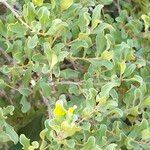A dense, twiggy evergreen shrub or small tree up to 7 m in height. Bark: grey, scaly, longitudinally fissured or cracked; branchlets twiggy, angular and densely leafy; all young parts covered with a granular rust-coloured exudate. Leaves: opposite to sub-opposite or in whorls of 3-4, mostly towards the ends of the branchlets, small, obovate to narrowly elliptic, 2-4 x 0, 5-1, 5 cm, stiff, leathery, dark green or blue-green above, paler below, sometimes rusty brown, with a granular exudate; apex broadly tapering or rounded to abruptly attenuate; base tapering; margin entire, finely rolled under, conspicuously wavy or almost flat; petiole 1-3 mm long. Flowers: small, whitish, in unbranched 5-to 7-flowered spikes up to 2 cm long, hairless but with rust-coloured stalked glands, solitary in the leaf axils; bracts boat-shaped, glandular; ovary hairless but with whitish scale-like glands (Dec.-Apr.). Fruit: round, 4-7 mm in diameter, thinly fleshy, reddish brown becoming black, in very short sprays less than 1.2 cm long (Feb.-Oct.).
Evergreen tree or shrub, 0.5-7.0 m high; bark grey, scaly; branchlets densely leafy; young parts covered with rust-coloured glands. Leaves opposite to subopposite or pseudo-whorls of 3 or 4, petiolate, obovate to elliptic, dark green above, sparingly to densely covered with rust-coloured glands below, margins entire, undulate to flat. Inflorescence axillary, 5-20 mm long, glands stalked and rust-coloured; 5-7-flowered. Flowers small, whitish, fragrant. Flowering time Nov.-May. Fruit a berry, globose, fleshy, red turning purple or black. Seeds 3-4 mm in diam.
Evergreen shrub or tree, 0.75-5.00(-7.00) m high. Branches covered with rust-brown scalelike glands when young. Leaves subopposite or alternate; blade narrowly elliptic, elliptic or narrowly obovate-elliptic, usually 4 x as long as broad. Flowers: in axillary inflorescences, 5-7-flowered, 5-20 mm long; ovary covered with grey scale-like glands; corolla up to 2 mm long, cleft halfway down, white, greenish white or cream-coloured; Dec., Jan. Fruit 4-6 mm in diameter, red turning purple or black when ripe.
A small tree. The crown is round. They can be 6 m tall. There are many branches. The leaves are simple and small. They are 1.3-4 cm long by 6-15 mm wide. They are often clustered near the ends of branches. The flowers are small and white or yellow. They have a smell. Flowers occur in clusters in the axils of leaves. Trees are separately male and female. The fruit are small berries which turn red then black. They have one seed. The fruit are edible.
Leaves usually opposite or subopposite; petiole up to 0·3 cm. long; lamina up to 4 cm. long and 1·5 cm. broad, mostly obovate, oblanceolate or oblanceolate–elliptic, apex obtuse to broadly rounded, base cuneate, but not concave, margin often strongly undulate; lower surface glabrous except for peltate scales; lateral nerves and veins almost invisible.
Evergreen, dioecious shrub or tree, up to 7 m tall, rusty granular on young parts. Leaves oblanceolate, firm, often dark green above, paler beneath, usually undulate. Flowers in axillary racemes, small, glabrescent, deeply cleft, cream-coloured, fragrant, ovary scaly. Fruit globose, ± fleshy.
Evergreen shrub or tree, 0.75-5.00 m or up to 7 m high. Leaves, twigs and corolla as in var. undulata, but leaves narrowly elliptic, elliptic or oblanceolate-elliptic, tapering ± equally to apex and base. Flowers white, greenish white or cream.
Dioecious shrub or tree to 7 m, rusty granular on young parts. Leaves oblanceolate, rusty granular, leathery, often undulate. Flowers in rusty granular, axillary racemes, glabrescent, deeply cleft, cream-coloured, fragrant, ovary scaly.
Distinguished from var. undulata by the narrowly-elliptic, elliptic or oblanceolate elliptic leaves which taper more or less equally to apex and base and are at least 4 times, as long as broad.
Corolla deeply lobed, widely open at the throat, each lobe with 0–20 (28) strigulose hairs.
Calyx patelliform, denticulate, glabrous except for peltate scales.
Inflorescence solitary in leaf–axils, unbranched, c. 1 cm. long.
Ovary covered with whitish scales, otherwise glabrous.
Young shoots glabrous except for rusty peltate scales.
Evergreen shrub or small tree up to 6 m. tall.
Stamens c. 16, glabrous or strigulose.
Pistillode with 2 simple stylodes.
Female flowers without staminodes.
Male flowers c. 0·3 cm. long.
Fruit c. 0·7 cm. diameter.


